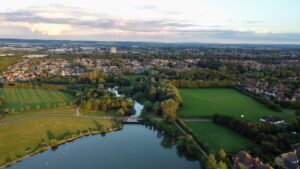In an era characterised by ‘turbulence’ and ‘disruption’, climate change has become an issue that local authorities can no longer ignore, writes Edward Nash of regeneration consultancy Nash Partnership.
The prominence of climate change can be seen in the protests in our cities, record numbers of Green Party councillors and MEPs and hundreds of local authorities declaring climate emergencies in response to a growing clamour for action.
Many councils have set a target for zero carbon emissions by 2030, which is 20 years ahead of the government’s ambition for the UK.
The shift will bring drastic changes across every aspect of how we live if it is to be achieved. It certainly requires a rethink around sustainable ways of living and alternative built environments. Until now, this has been largely framed in a technical context directed at the development industry’s outputs.
If we are to fully embrace the changes that need to happen and accept that we all play a role in creating sustainable communities, we need to think about the role the places we live and work in play in supporting this shift. As everyday things that we value come under threat, we need to look at this challenge differently.
How the built environment can drive sustainable change
The built environment determines the choices we make: where and how we live, travel, work and consume things can all be impacted, in different ways.
It’s becoming clearer to increasing numbers of people that the latter half 20th century’s ‘suburban dream’ was driven by marketing and saw home-owners as consumers. It has shaped policies and behaviours that have proved to be unsustainable.
From sub-regional planning to community regeneration, there are opportunities for all those involved in the built environment to reset the blueprint to influence positive behaviours.
Looking at change on an individual level, there are three areas that demand a focus from national and local policy makers, development industry leaders and supply and service businesses to support this change.
Shift from two-car families to shared transport.
The twentieth-century model for development was based around the idea of suburban home-ownership and commuting by private car.
As cities have become more congested and house prices have rocketed, this type of living has become unsustainable and out-of-reach for millions of people.With city centre sites now earmarked for new homes, developments are identifying alternative travel needs and options into their schemes.
We are also seeing through our engagement with developers on town and city centre regeneration developments that people are increasingly asking for this: they don’t want or can’t afford two parking spaces. Embracing this can play a big role in bringing forward a sustained shift to cleaner, shared modes of travel.
From individual to social experiences
The creation of common spaces and shared gardens can help improve people’s wellbeing, skills and strengthen community links. Recently, we have engaged downsizing households asking for ‘social gardening’ provision instead of individual garden plots on the regeneration of a former industrial site in the centre of Frome in Somerset.
Frome has pioneered the spirit of sharing: its Library of Things enables people to borrow everyday items that many people own, but do not make good use of — like a power drill or family camping equipment, for example. Developing opportunities for people to share spaces and resources can positively impact local food production and how we buy things.
Creating urban spaces where local food markets can happen has worked brilliantly on several schemes we have supported in the South West.
Flexible, adaptable, local
Successful urban places bear a hallmark of local distinctiveness, which taps into a desire for authenticity and something ‘different’.
Pop-up shopping and flexible workspace are clear examples of this and pose a challenge to the traditional retail and office models.
Whilst the future of the high street or the office is hard to predict, it’s clear to see that those who adapt and innovate will prevail.
Places that can accommodate local businesses, food producers and readily morph between uses will stand a great chance of success.
Do we need so much stuff?
There is a bigger question around values and how these shape our choices. But it’s also true that policies and positive action can make those choices easier, which in turn enables positive action to happen.
Taken together, these changes could kick start a trend that moves us away from a pattern of behaviour that sees us buy, consume and dispose of stuff.
We know that driving less, buying locally and understanding the impacts of our lifestyle hold the key to a more sustainable future.
If we are going to achieve carbon neutrality by the end of the next decade, we need to take more proactive interventions to shape different patterns of behaviour.
Local authorities, institutions and businesses will need to do more to help households and individuals take a leading role.
The opportunities this presents are more exciting than they have been for many years. Enabling people and businesses to make daily choices for the good of their communities is incredibly rewarding.
In grasping these opportunities, we can be the change that people want to see.
Photo Credit — Pixabay
















Leave a Reply